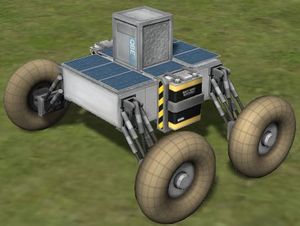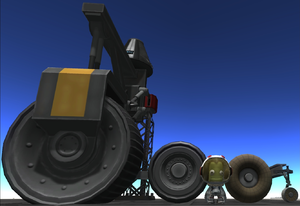Difference between revisions of "Rover"
(→Piloting rovers) |
|||
| Line 30: | Line 30: | ||
When driving a rover, you have to be aware that the wheels are flimsy. When they experience strong impacts, they can get "broken". In this state they are still intact as a part, but do not work as a wheel anymore. The impact threshold for this to happen is a lot lower than the actual impact tolerance listed in the parts menu. Wheels easily break when you let the rover jump, so it is recommended to reduce your speed when you drive over a hill. They can also break when you get faster than the maximum speed of the wheels, which can easily happen when you drive down a slope or use rocket thrusters to accelerate a rover to higher speeds than it could reach on its own. | When driving a rover, you have to be aware that the wheels are flimsy. When they experience strong impacts, they can get "broken". In this state they are still intact as a part, but do not work as a wheel anymore. The impact threshold for this to happen is a lot lower than the actual impact tolerance listed in the parts menu. Wheels easily break when you let the rover jump, so it is recommended to reduce your speed when you drive over a hill. They can also break when you get faster than the maximum speed of the wheels, which can easily happen when you drive down a slope or use rocket thrusters to accelerate a rover to higher speeds than it could reach on its own. | ||
| − | Fortunately, broken wheels can be fixed by Kerbonauts. To do so, perform an [[EVA]], walk close to the damaged wheel, right-click it and click on "repair". The wheel will immediately be operational again. | + | Fortunately, broken wheels can be fixed by Kerbonauts. To do so, perform an [[EVA]], walk close to the damaged wheel, right-click it and click on "repair". The wheel will immediately be operational again. If repaired while moving over the ground it can fling a light vehicle and possibly damage it. |
Revision as of 13:16, 24 May 2013
Rovers are a new feature in Version 0.19. They are ground vehicles equipped with wheels, allowing them to travel around the surface of any celestial body.
Constructing rovers
Basics
To build a rover, you have to add wheels to your vehicle. You find these in the utility section. To allow the vehicle to drive straight, the wheels must be parallel. But they detect automatically in which direction they are facing, so you don't have to worry about placing them backwards.
Wheels require lots of Electricity to operate, so a rover should be equipped with generous energy supply in form of batteries and/or a sustainable energy sources in form of solar panels or radioisotope generators. Most players prefer solar panels due to their lower weight. But keep in mind that extended solar panels can easily be destroyed by atmospheric drag when on a fast-driving rover on a planet with atmosphere.
| Image | Part | Radial size | Cost ( |
Mass (t) |
Max. Temp. (K) |
Tolerance (m/s) |
Tolerance (g) |
Electricity (⚡/s) |
Max. Motor Speed (m/s) |
Brake Torque (kNm) |
|---|---|---|---|---|---|---|---|---|---|---|
| RoveMax Model S2 | Radial mounted | 300 | 0.05 | 1 200 | 20 | 20 | 1.0 | 12 | 0.34 | |
| RoveMax Model M1 | Radial mounted | 450 | 0.075 | 1 200 | 50 | 50 | 2.5 | 34 | 2 | |
| TR-2L Ruggedized Vehicular Wheel | Radial mounted | 760 | 0.105 | 1 200 | 100 | 80 | 3.5 | 58 | 3 | |
| RoveMax Model XL3 | Radial mounted | 1 200 | 1.25 | 1 200 | 150 | 200 | 5.0 | 15.5 | 30 |
Advanced
To create a rover which is easy to control, you should try to build it relatively wide and with a low center of mass. This makes it much harder for the rover to topple over when driving fast curves, accelerating or breaking. Rovers are less stable when in low gravity, so a rover which is almost impossible to flip over on Kerbin might still require some care on Minmus, for example.
On small rovers, LT-1 Landing Struts can be used to turn them back over when they end up upside down. Larger rovers on low-gravity worlds can help themself up by using RCS Thrusters.
To give rovers some more acceleration, RCS or even rocket thrusters can be added to them.
Piloting rovers
Per default, a rover is controlled with the keys A, D, W and S. Unfortunately these keys also control vehicle rotation, which can make a rover completely uncontrolable on planets with low gravity. As a workaround for this problem, many players map the rover controls to different keys in the settings menu. Another solution is to switch into docking mode when controlling a rover.
Note: Using Docking Controls, as opposed to Staging controls (particularly in "UN" mode - you can switch with Space if you're in the other) disables vehicle pitching. Coupled with pitching being active in the other mode of Docking, with a single click of the Space button, players can easily switch between vehicle pitching on and off, therefore giving a stable mode of acceleration/direction change and a quick way to adjust the pitch of the rover on low gravity planets, should it be tipped or launched over a hill.
When driving a rover, you have to be aware that the wheels are flimsy. When they experience strong impacts, they can get "broken". In this state they are still intact as a part, but do not work as a wheel anymore. The impact threshold for this to happen is a lot lower than the actual impact tolerance listed in the parts menu. Wheels easily break when you let the rover jump, so it is recommended to reduce your speed when you drive over a hill. They can also break when you get faster than the maximum speed of the wheels, which can easily happen when you drive down a slope or use rocket thrusters to accelerate a rover to higher speeds than it could reach on its own.
Fortunately, broken wheels can be fixed by Kerbonauts. To do so, perform an EVA, walk close to the damaged wheel, right-click it and click on "repair". The wheel will immediately be operational again. If repaired while moving over the ground it can fling a light vehicle and possibly damage it.



